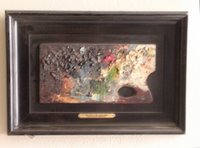Otto Hake
 Almost certainly it was Otto Hake who held a membership in the Palette and Chisel for longer than anyone else. Hake was a member of the P&C from 1905 to at least as late as 1957; he died in 1965. He served a term as president of the club and was on the board of directors. His murals decorate the office downstairs--at one time it was the billiards room. Hake's portrait, by Oskar Gross, hangs in the back room. Several of his old books--with the bookplate he designed for himself still in them--can be found in the club library. Hake drew the map of the club's summer camp, and his advertising illustrations--beautiful pen and ink drawings--can be found in back issues of the club's newsletter. His wedding engagement to a Russian figure model made the Chicago newspapers. In short, Hake's influence at the P&C can be felt everywhere.
Almost certainly it was Otto Hake who held a membership in the Palette and Chisel for longer than anyone else. Hake was a member of the P&C from 1905 to at least as late as 1957; he died in 1965. He served a term as president of the club and was on the board of directors. His murals decorate the office downstairs--at one time it was the billiards room. Hake's portrait, by Oskar Gross, hangs in the back room. Several of his old books--with the bookplate he designed for himself still in them--can be found in the club library. Hake drew the map of the club's summer camp, and his advertising illustrations--beautiful pen and ink drawings--can be found in back issues of the club's newsletter. His wedding engagement to a Russian figure model made the Chicago newspapers. In short, Hake's influence at the P&C can be felt everywhere. Here are a couple photos of Hake's murals in the office.

 Yes, those are bullet holes. Why someone shot up the murals, I don't yet know.
Yes, those are bullet holes. Why someone shot up the murals, I don't yet know. Hake did other mural work in the area, including two for the DuPage Historical Society, several for the Black Hawk Lodge at Black Hawk State Park in Rock Island, and several for a one-time athletic club at Chestnut and Lake Shore Drive in Chicago.
Here is a photo of one of his bookplates:

And here is a photo of Otto Hake and Rudolf Ingerle from what must have been a painting trip to Brown County, Indiana:

In a brief autobiography--written for the December 1925 issue of the club newsletter--Hake says that he was born in Ulm, Germany and came to America at the age of fourteen. (He was born in 1876, so he would have arrived in the U.S. in 1890.) "I tried a number of occupations and learned to know well the sensation of being fired," he wrote. After stints as an apprentice to a wood engraver in St. Louis and then to a newspaper artist, Hake enlisted for the Spanish-American war. Though "never given a chance for heroism," Hake reached the age of twenty-one in the military and became an American citizen.
In 1902 he moved to Chicago, where he went to work for the Binner-Wells Company--designers, engravers, and printers--on South Michigan Avenue.

While at Binner-Wells, Hake met Fred Larson, one of the founders of the club. Larson, Hake wrote, "gave me the first impetus towards out-door sketching in water colors. He was instrumental in securing my acceptance in the Palette and Chisel Club in the fall of 1905. My history since then is merged in the history of the Club."
Hake relates that after joining the club, he set out to be a freelance illustrator and designer. He taught composition at the Fine Arts Academy.
Hake:
The sale of some paintings about that time proved disastrous to my peace of mind, for that little success aroused a desire to enter the higher realms of art expression, and led to a study trip through Europe with Henry Thiede and John Woodruff during 1912-13. This resulted in a realization of my deficiencies and all the years that have passed since have been sent in a vain endeavor to correct them, using up time and expensive materials which might have been employed towards more profitable production.Few of us seem to have been warned off by Hake's example. Indeed some of us are positively encouraged.
Thus the age of forty-nine finds me a bachelor without serious responsibilities, still hoping to carry my abilities to a higher level and again, perhaps, to serve a warning to my younger colleagues.


3 Comments:
Hake Mural bullet holes:
I heard somewhere that the son of someone who was serving as the resident manager was the guilty party. Apparently he was drunk at the time.I either got this information from Frank Hensley or from Patrick McCearnan a former Resident manager who had the job before I did it.
As the car grill in the photo of HAke and Ingerle clearly says "Bryson City," I think the picture must have been taken in the Smokies, in NC, not Brown County.
cheers,
wg
Thanks, Wendy.
(your eye is much sharper than mine!)
Post a Comment
<< Home